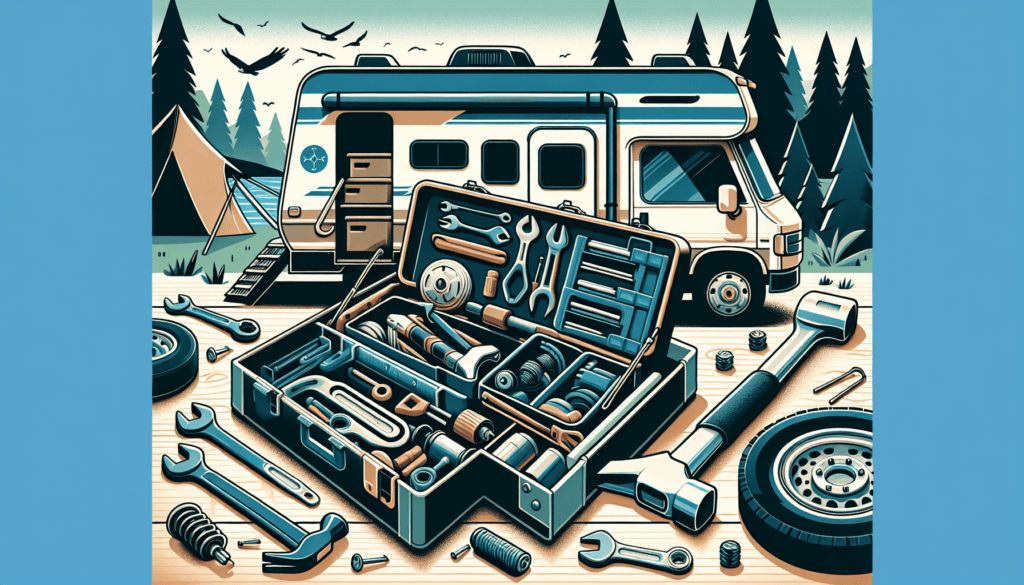Maintaining your RV is crucial to ensure its longevity and functionality on the road. With the “RV Maintenance Log,” keeping track of all the necessary repairs, inspections, and maintenance activities has never been easier. This handy tool helps you stay organized and proactive, allowing you to effectively plan and prioritize tasks, and ultimately enjoy worry-free adventures in your beloved RV. Say goodbye to overlooked maintenance issues and embrace a hassle-free journey filled with unforgettable memories.
Importance of Keeping an RV Maintenance Log

1.1 Track and Plan Maintenance Tasks
Keeping a maintenance log for your RV is important for tracking and planning your maintenance tasks. By recording each maintenance activity, you can easily keep track of when tasks were last performed and when they are due again. This helps you stay organized and ensures that you don’t miss any important maintenance tasks.
Having a log also allows you to plan your maintenance tasks in advance. By knowing when certain tasks are due, you can schedule them at a convenient time, avoiding any last-minute rush or inconvenience. This ensures that your RV remains in top condition and reduces the risk of unexpected breakdowns or malfunctions.
1.2 Ensure Proper Care and Preventive Maintenance
An RV maintenance log is an invaluable tool for ensuring proper care and preventive maintenance for your vehicle. By consistently performing regular maintenance tasks and recording them in your log, you can extend the lifespan of your RV and keep it running smoothly.
Regular maintenance tasks such as oil changes, filter replacements, and tire rotations are essential for maintaining the performance and efficiency of your RV. These tasks help prevent the buildup of dirt, debris, and wear and tear that can lead to larger issues down the line. By logging these tasks, you can ensure that they are carried out on time and in accordance with manufacturer recommendations.
1.3 Monitor RV Performance and Efficiency
Another crucial benefit of maintaining a log is the ability to monitor the performance and efficiency of your RV. By recording important details such as mileage, fuel consumption, and any changes or issues you notice, you can identify patterns or trends that may indicate potential problems.
Monitoring and analyzing your RV’s performance can help you catch any issues early on, before they develop into larger and more costly problems. It also allows you to track the effectiveness of any maintenance or repairs you have performed, ensuring that you are getting the most out of your investment.
2. Creating an RV Maintenance Log
2.1 Choosing the Right Format
When creating your RV maintenance log, it’s important to choose a format that works best for you. Whether you prefer a physical notebook, a digital spreadsheet, or a mobile app, the key is to find a format that is convenient and easy to use.
Consider factors such as accessibility, ease of data entry, and the ability to organize and analyze the information. Find a format that suits your preferences and makes it easy for you to record and track your maintenance activities.
2.2 Organizing the Log
To ensure the effectiveness of your maintenance log, it’s important to keep it organized. Create sections or categories for different types of maintenance tasks, such as regular, seasonal, and long-term maintenance. This will make it easier to locate and review specific tasks when needed.
Consider using headings and subheadings to clearly separate different types of maintenance tasks. Additionally, you can color-code or use different symbols to visually distinguish between completed and upcoming maintenance tasks.
2.3 Including Essential Information
In your maintenance log, make sure to include essential information for each maintenance activity. This may include the date the task was performed, the mileage of your vehicle at the time, and a brief description of the task. Adding information such as the parts and supplies used, costs, and service providers can also be helpful for future reference.
Including this information allows you to have a comprehensive record of all maintenance activities, making it easier to track and analyze your RV’s maintenance history.
3. Types of Maintenance to Log
3.1 Regular Maintenance Tasks
Regular maintenance tasks are those that need to be performed on a recurring basis to keep your RV in good condition. This may include tasks such as oil changes, filter replacements, fluid checks, and inspections.
By logging these regular maintenance tasks in your maintenance log, you can ensure that they are performed at the recommended intervals and avoid any potential issues caused by neglecting them.
3.2 Seasonal Maintenance Tasks
Seasonal maintenance tasks are those that need to be done at specific times of the year to prepare your RV for different weather conditions. This may include tasks such as cleaning and inspecting the roof, checking and maintaining the HVAC system, and preparing the RV’s water and plumbing systems for winter or summer use.
Logging these seasonal maintenance tasks helps you stay on top of necessary preparations and ensures that your RV is in optimal condition for each season.
3.3 Long-term Maintenance Tasks
Long-term maintenance tasks are those that may not need to be performed as frequently but are essential for keeping your RV in good shape over time. This may include tasks such as engine and transmission maintenance, generator servicing, and chassis inspections.
By logging these long-term maintenance tasks, you can ensure that they are not overlooked and are scheduled at the appropriate intervals based on manufacturer recommendations.
4. Recording Maintenance Activities
4.1 Logging Date and Mileage
When recording maintenance activities in your RV maintenance log, be sure to include the date the task was performed and the mileage of your vehicle at that time. This information helps you track the timing and frequency of each task, making it easier to plan for future maintenance needs.
By logging mileage, you can also monitor fuel efficiency and identify any significant changes that may require attention or further investigation.
4.2 Describing the Maintenance Task
For each maintenance task recorded in your log, provide a brief description of what was done. This description should be clear and concise, outlining the scope of the task and any specific details that may be relevant in the future.
By having a clear description, you can easily recall what was done during past maintenance activities and ensure that tasks are not duplicated or overlooked.
4.3 Noting Parts and Supplies Used
In your maintenance log, note the parts and supplies that were used for each maintenance task. This information is valuable for future reference, as it allows you to track the lifespan of various components and plan for replacements accordingly.
By noting the parts and supplies used, you can also identify any recurring issues or trends that may require attention or further investigation.
4.4 Indicating Costs and Service Providers
Recording the costs associated with each maintenance task and noting the service provider can be helpful for budgeting and tracking expenses. This information allows you to have a clear overview of the costs involved in maintaining your RV and helps you identify any potential opportunities for cost-saving measures.
By indicating the service provider, you also have a record of who performed the maintenance task, which can be useful when seeking professional assistance or warranty services.
5. Implementing a Maintenance Schedule
5.1 Setting Maintenance Intervals
One of the key benefits of an RV maintenance log is the ability to set and follow a maintenance schedule. By knowing when specific tasks are due, you can create a schedule that ensures timely completion of each maintenance activity.
Consider the manufacturer’s recommendations as a starting point when setting maintenance intervals. However, keep in mind that individual usage patterns, climate conditions, and other factors may warrant adjustments to the recommended intervals. Regularly reviewing and updating your schedule based on your RV’s specific needs is crucial for optimal maintenance.
5.2 Creating Reminders
To help you stay on top of your maintenance schedule, create reminders for upcoming tasks. This can be done using physical reminders such as sticky notes or by setting digital reminders on your phone or computer.
Having reminders ensures that no maintenance tasks are overlooked or delayed, reducing the risk of potential issues or breakdowns.
5.3 Following Manufacturer Guidelines
While it’s important to establish a maintenance schedule that suits your RV’s specific needs, it’s also crucial to follow the manufacturer’s guidelines. Manufacturers often provide maintenance recommendations tailored to the specific make and model of the RV, taking into account factors such as warranty requirements and optimal lifespan.
By following these guidelines, you can ensure that the maintenance performed is in line with industry best practices and helps maintain the value and performance of your RV.
6. Troubleshooting and Problem-Solving

6.1 Noting Malfunctions and Repairs
In addition to regular maintenance tasks, it’s important to record any malfunctions or repairs in your maintenance log. This information helps you identify recurring issues and patterns that may require professional attention or further investigation.
By noting malfunctions and repairs, you can also have a comprehensive record of the steps taken to resolve the issues, which can be useful for future reference or warranty claims.
6.2 Identifying Patterns and Trends
Analyzing the information in your maintenance log allows you to identify patterns and trends that may indicate underlying problems or potential areas for improvement. By tracking and comparing data over time, you can spot changes in performance, efficiency, or reliability and take appropriate action.
For example, if you notice that certain components consistently require more frequent replacements or repairs, you may need to investigate the root cause or consider upgrading to higher-quality parts.
6.3 Seeking Professional Assistance
While maintaining a maintenance log is an excellent tool for DIY maintenance and troubleshooting, there may be situations where professional assistance is necessary. If you encounter complex issues or are unsure about the proper course of action, don’t hesitate to consult a qualified RV technician or mechanic.
Professional assistance can help ensure that any issues are properly diagnosed and resolved, preventing further damage or costly repairs.
7. Benefits of Regular Maintenance
7.1 Prolonging RV Lifespan
Regular maintenance is key to prolonging the lifespan of your RV. By following a maintenance schedule and addressing any potential issues or wear and tear in a timely manner, you can keep your RV running smoothly for many years to come.
Proper maintenance helps prevent small problems from turning into major repairs, saving you time, money, and frustration in the long run. By taking care of your RV, you can enjoy your travels worry-free and maximize the return on your investment.
7.2 Ensuring Safety on the Road
Keeping up with regular maintenance tasks is essential for ensuring your safety and the safety of others on the road. By regularly inspecting and maintaining critical components such as brakes, tires, and lights, you can minimize the risk of accidents and breakdowns.
Safe and reliable RV operation relies on proper maintenance, so don’t underestimate the importance of a well-maintained vehicle.
7.3 Avoiding Expensive Repairs
One of the significant advantages of maintaining a maintenance log and following a schedule is the potential to avoid expensive repairs. By addressing issues early on and keeping your RV in good condition, you can catch potential problems before they escalate and require costly repairs.
The cost of regular maintenance is often much more affordable compared to major repairs, and it helps you avoid unexpected expenses that can put a strain on your budget.
8. Staying Organized and Consistent
8.1 Routine Data Entry
To ensure the effectiveness of your maintenance log, make a habit of entering data regularly. Set aside time at the end of each maintenance task to update your log, recording the necessary details while they are still fresh in your mind.
By making routine data entry a consistent practice, you can maintain an accurate and up-to-date log that serves as a reliable reference and planning tool.
8.2 Organizing Maintenance Records
In addition to maintaining a maintenance log, it’s important to keep your physical or digital maintenance records organized. Store invoices, receipts, and other relevant documents in a designated folder or file to have a comprehensive record of each maintenance activity.
Organizing your maintenance records ensures easy access to important information when needed, such as when selling your RV or seeking warranty claims.
8.3 Reviewing and Analyzing Log Entries
Regularly reviewing and analyzing the entries in your maintenance log is essential for maintaining optimal RV performance. Look for patterns or trends that may indicate potential issues, consider adjustments to your maintenance schedule if necessary, and use the data to make informed decisions regarding repairs or upgrades.
By actively reviewing and analyzing log entries, you can stay proactive in maintaining your RV and avoid any surprises or breakdowns on the road.
9. Utilizing Technology for Maintenance Tracking
9.1 RV Maintenance Mobile Apps
In the age of digital technology, there are various mobile apps available that can help you track and manage your RV maintenance. These apps often offer features such as maintenance reminders, service history tracking, and customization options to suit your specific needs.
Using a mobile app can streamline the maintenance tracking process, making it more convenient and accessible whenever and wherever you need it.
9.2 Digital Maintenance Spreadsheets
If you prefer a more customizable and versatile format, digital maintenance spreadsheets can be a great solution. Programs like Microsoft Excel or Google Sheets allow you to create personalized maintenance logs with features such as automatic calculations, conditional formatting, and data analysis tools.
Using digital maintenance spreadsheets provides flexibility in organizing and analyzing your maintenance data, making it easier to identify patterns, trends, and areas of improvement.
9.3 Online Maintenance Tracking Platforms
For those who prefer a cloud-based approach, online maintenance tracking platforms can offer a convenient solution. These platforms allow you to access and update your maintenance log from any device with internet connection, ensuring that your data is always backed up and accessible.
Online maintenance tracking platforms often provide additional features such as collaboration options for multiple users, integration with other apps or devices, and the ability to generate reports or export data for analysis.
10. Conclusion
Keeping a comprehensive RV maintenance log is essential for every owner. By tracking and planning your maintenance tasks, ensuring proper care and preventive maintenance, monitoring performance and efficiency, and troubleshooting issues, you can prolong the lifespan of your RV, ensure safety on the road, and avoid expensive repairs.
When creating your maintenance log, choose the right format that works best for you, organize it effectively, and include essential information for each maintenance task. Implementing a maintenance schedule, following manufacturer guidelines, and utilizing technology for tracking can further enhance the effectiveness of your maintenance log.
Remember, staying organized and consistent, regularly reviewing and analyzing log entries, and seeking professional assistance when needed are vital for maintaining optimal RV performance.
By prioritizing regular maintenance and keeping an accurate and up-to-date maintenance log, you can enjoy worry-free travels and maximize the enjoyment and longevity of your RV.


